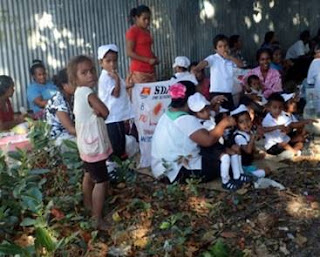The particular island we are visiting today is Fanning Island, an atoll with a total land area of 13 square miles spread out in a ring around a lagoon of 426 square miles. Because the deepest part of this saltwater lagoon is only 50 feet, the color of the water is turquoise blue to azure in places.
Way back in 1798, American Captain Edmund Fanning discovered this atoll, mostly because of the native bush and coconut trees reached 60 to 90 feet, making this atoll visible from a greater distance. There was not one living soul on this island at the time. Later, in 1857, William Greig arrived here and declared that he was the King of Fanning Island. Eventually, in the 1980's, more natives from the surrounding atolls were re-located here to alleviate overpopulation. Today, about 2000 people live here, mainly employed to grow coconuts and farm seaweed for export.
The Amsterdam arrived outside the English Channel Pass, where it may or may not have dropped anchor. Sometimes where there is an abundance of coral, the ship can be held in place with the side thrusters. Our stay today was between 8am to 1:30pm, a very short one. For that reason, we chose to skip breakfast, meet with Christel, who escorted our small group down to deck A, and be among the first over to the atoll. We were joined by a half dozen other folks, who we assume were deck seven.
We figured by going over early, it may not be too hot yet. It was very humid however, and that gets to you faster than the heat. We watched for dolphins on the way through the turbulent opening from the ocean to the lagoon, but did not see any. Maybe later………..
There is a small pier that sticks out into the lagoon, and we soon realized that it was new from last year's pier. No need for the crew to bring over plywood and screw guns to re-enforce the structure before we got there, like they usually do.
The greeting for our group was a choir of girls, singing, as we came ashore. Some of the adult locals were dressed in native costumes, chanting and dancing for us all. A couple hundred of the natives had tables of souvenirs set up for us to purchase. Mostly shell-made baskets, bracelets, and necklaces, and all hand-made. There were knives carved from wood and decorated with sharp shark teeth. Definitely something for everyone, and a donation that will be put to good use.
Nearby this landing is their marketplace, which really is a huge shed that holds staples. It was closed today, because they only have enough to sustain themselves. Judging from the trash we found along the roads, they eat a whole lot of snack foods in small packages. And canned foods, since we saw lots of that laying around. It is most common to see fires where this trash is piled, then burned….eventually.
Outside the marketplace, a group of pre-schoolers was singing for the growing crowd from the ship. It appears that more than half of the population are kids under 12 or 13. The older ones may have been off fishing or working the coconut farms with the men.
Deciding to check out the souvenir tables later, we headed up the road of crushed coral and sand. Filled with deep ruts, it was a bit easier walking this year, because it had not rained the night before. No deep puddles to negotiate. Most everyone here rides a bike, and a few have motor bikes. We did see a few longbed trucks that have been converted to take folks on a $10 tour. Not a bad idea for those that can't take the heat, or simply cannot walk too far.
All the roadside homes are simple huts. Cooking is done outdoors, but without the convenience of electricity. Water is supplied by crude wells or the newer plastic rain water collectors. Some of the "bedrooms" are raised platforms with a thatched roof. Clothes were hung on lines to air dry, and probably all hand-washed.
In the yards, we saw a few cats, several chickens, pigs, and a whole lot of dogs. Making our way towards the lagoon side, we got to see the underwater seaweed beds and drying grounds on the small beaches. The school houses were empty today, since it was Saturday, the local date. By the way, this is the first time ever that we did not skip a day when we crossed the International Dateline before arriving here. So we kept Friday, the 14th, even though it was Saturday, the 15th here.
Eventually, we came to the church and the huge meeting hall. Local women were beginning to clean up around the outside, although, we are certain that the door to the church was never opened. The ship's map indicated that this was a Catholic church, however, there was nothing to indicate what it was…..no signage, or a cross.
We passed many natives on their way towards the pier. For the most part, only the women and children greeted us and wanted to know where we were from. The boys were more shy, hiding in trees or tagging alongside us. One such boy happened to have on the identical print shirt as mine. No kidding. I did make mine a few years ago with fabric from Hilo, but have never seen anyone else with the same print. Especially not here in the middle of the Pacific Ocean. Once it occurred to the little boy that we looked alike, he stuck to us like glue. That is, until someone else came along with chocolate candy from the ship, handing them out to a group of girls.
Quite often, passengers bring donations like school supplies, used clothing, or trinkets from their homeplace. Keyrings or city pins. We are sure the kids like candy better, but with little if any dental care, the sweets might not be a great idea.
By the time we made it back to the pier, hundreds of passengers had flooded the area. A small group was swimming in the lagoon, being most careful not to go anywhere near the lagoon entrance.
Near the end of the atoll, is a monument dedicated to those who came here in the late 1700's and 1800's. The walking became difficult here due to large rocks of coral that line the water's edge. These rocks wrap around the outside of the atoll, where swimming would be fatal because of the extreme currents and undertow.
Checking out the treasures being sold, we found a few pieces of shell jewelry to add to the collection. Several of the youngest children were huddled under the tables, staying out of the hot sun. It had sprinkled briefly, but stopped just as fast.
Even though we had brought some water with us, it wasn't enough. Thank goodness for the crew that handed out cold lemonade, although the line was long. Spending four hours here was sufficient. So we got on the next really crowded tender boat for the ride back. It got rough going through the channel, but the worst part was being held up at the ship's platform. Another boat was off-loading their guests, but at a snail's pace. The swell of the waves had slowed down the process, as well as the xray we go through after entering. For those reasons, it took 45 minutes to get back onboard. There has to be a better way to do this, which might include opening a second landing. To be fair, there are things we do not know about tendering, and the crew and staff do their utmost best to keep things safe.
Our timing was perfect for lunch in the dining room. Besides ice water, we must have emptied three glasses of ice tea with our pulled pork sandwiches. The best part was the wonderful air-conditioning. The dining room was busy this afternoon, and some late-comers had to be turned away.
The sail away did not happen until closer to 3pm, because of the delay in getting the folks back onboard. Friends told us that one boat had broken down at one point, and had to be towed back with all of the passengers onboard. Another delay occurred when a request was made by the islanders for much needed fuel for their generators. They had run short of their supply. Lucky we could help them out.
The boats had to be loaded also, a slow process to keep things safe. Great snacks and drink specials had been advertised on the Seaview deck, but somehow we missed seeing any of that. What we did see, made our day. Sensing in our bones, we kept a lookout for dolphins. Just about giving up, there they were, a small group swimming alongside, jumping in the ship's wake. It happened so quickly, but the good camera caught the action. The perfect ending to a unique port of call.
Working on photos and reports took the remainder of the afternoon, but in the comfort of our room. The highlight of our evening was another dinner in the Pinnacle Grill, where we found it quite busy. Caesar salad always starts off our meal, although we do miss the warm bacon and arugula salad, long gone from their menu. We both had steaks, mushrooms, and French fries.
On our way to dinner, we passed by the Queens Lounge and caught some of the show in progress. A group by the name of Vox Fortura was performing classical music. What a powerhouse of voices. They recently were semi-finalists on Britain's Got Talent. Hope they come back again, because we would like to see the entire show.
We now have three days at sea on our way to Pago Pago, American Samoa.
Bill & Mary Ann
 We had lots of space on the way over
We had lots of space on the way over
 Current is created with water flowing into the lagoon
Current is created with water flowing into the lagoon
 The newly-built pier – a huge improvement
The newly-built pier – a huge improvement
 The boats were busy all morning
The boats were busy all morning
 Don't want to miss the last tender
Don't want to miss the last tender
 Most vendors we have ever seen
Most vendors we have ever seen
 The Marketplace was closed today
The Marketplace was closed today
 Bikes are the best mode of transportation
Bikes are the best mode of transportation
 A haven for birds, although we saw few
A haven for birds, although we saw few
 Some buildings would hold up better in storms
Some buildings would hold up better in storms
 Remains of the old school huts
Remains of the old school huts
 Concrete buildings have taken their place
Concrete buildings have taken their place
 The cruise line NCL helped build this school years ago
The cruise line NCL helped build this school years ago
 Built to withstand storms and winds
Built to withstand storms and winds
 Resting, well someone has to do it
Resting, well someone has to do it






































































